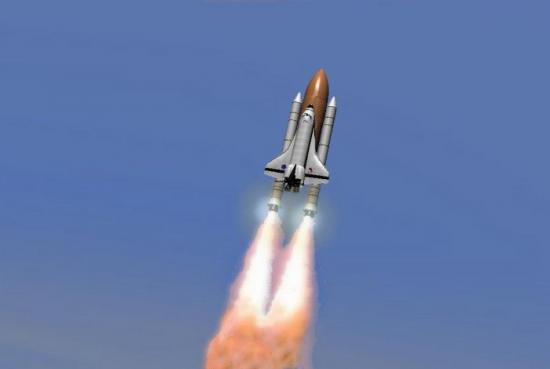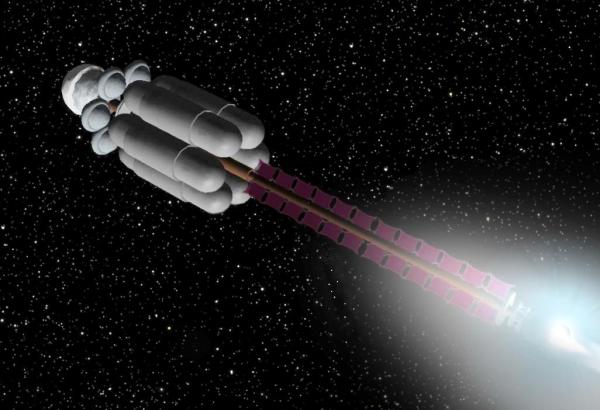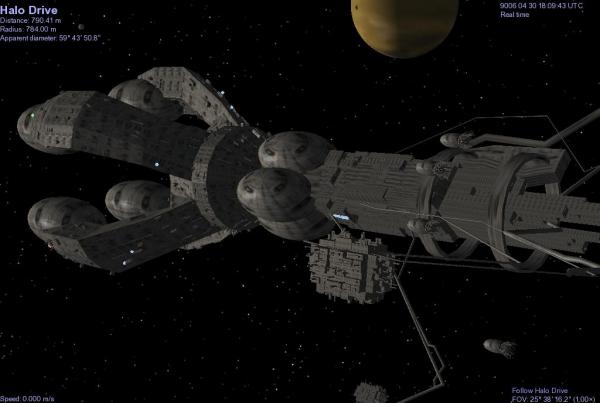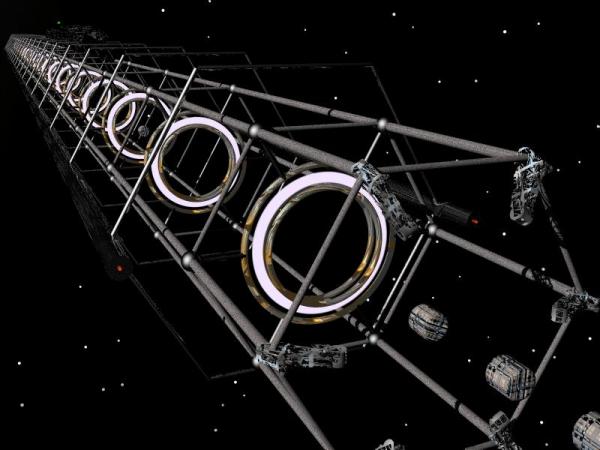BY LETTER
Propulsion Technology
The propulsion of spacecraft using rocketry and reactionless methods | |
 Image from Steve Bowers Shuttle mesh by Jack Higgins | |
| Shuttle, a very early chemical rocket from Old Earth's Information age | |
Toposophic Level and Drive Technology
The type of ship and ship propulsion or drive used has varied greatly throughout the history of the Terragen colonisation of space. In general, the toposophic level required to develop, manufacture, and control the various drives is the largest determinant of the power, capability, and usefulness of the drives.The lowest sophont level known to produce capable space drives is S:0, the ubiquitous modosophonts. Representative S:0 drives are adequate for intrasystem purposes and can even make short interstellar journeys up to perhaps a dozen light years on a regular basis. Heavily optimized modosophont hybrid designs are even more capable than that, able to reach a notable fraction of c (the speed of light; an ultimate speed limit for anything that has mass) and have a practical range approaching 100 light years.
Higher sophont levels have vastly greater capabilities, as noted in more detail below.
The Structure of Space
Early in history, space was thought to be an empty void. The ancestral humans of Earth, as they struggled to reach space, developed equations for the effort that assumed space to be nothing. These are the ancient rocket equations still taught today, even though they only apply to the low speed regime of space travel, used only for short ranges and by the Haloists.As we all know, space is not nothing. As more and more experience was gained in space travel at higher and higher energy levels, it became obvious that space was not empty, and had structure, together with resources and hazards.
Over the many millennia of the Terragen expansion, long-distance space travel has become routine, and several broadly defined regimes of that travel have become widely recognized.
Interstellar Travel regimes
1) Low Speed: In general, low speed interstellar travel is anything below 0.3c. The upper boundary of the low speed regime is the point where the interstellar medium can be gathered effectively via ramscoops. At 0.3c and below shielding requirements are not nearly as rigorous, effective maneuvers can be taken in extreme cases, and space travel is generally quite easy. The vast metaempire of the Deeper Covenant is by far the largest user of this regime of space travel, and large numbers of sophonts and considerable amounts of material move between the worlds using this regime.2) High Speed: In broad terms, high speed interstellar travel falls in the regime between 0.2c and 0.84c. The relevant boundaries of this regime at the lower end is the point at which optimised ramscoops can obtain significant mass flows, and the upper boundary is the point at which relativistic mass effects make further ram-powered acceleration impossible even with total conversion drives.
3) Relativistic: In broad terms, this is the regime above 0.84c in which relativistic effects dominate. The beneficial effects of this regime are heavy time-dilation and minimized transit times. The negative aspects are the very high energy and shielding requirements.
4) Spacetime Structural: In broad terms, this regime is defined by modifying the space-time the craft is traveling through, allowing the vessel to move through space as a result of this modification. It is also possible to use this structural deformation of space-time to protect the craft. Only transapients at the S6 level can design and create craft which use this structural deformation reliably as a form of propulsion.
In general terms, S:0 technologies can reach only the Low Speed and somewhat into the High Speed regimes. S:1, S:2, and S:3 technologies can reach the High Speed and into the bottom of the Relativistic regimes. S:4, S:5, and S:6 technologies can reach the High Speed, Relativistic, and Spacetime Structural regimes.
A note on terms: Many examples are quoted below for S:0 drives that give ranges of specific impulse (Isp), delta-v, and thrust-to-weight ratios. A word of explanation of these terms is required:
- Specific Impulse is a common measure of how much thrust you can gain for a given length of time using a given mass of propellant.
- Delta-v is the total amount of acceleration and deceleration (which is really just acceleration on a different vector) which a ship using this drive can achieve. For simplicity, only "reasonable" mass fractions are explored: It is possible to get very high delta-v figures for any drive if you devote 99.99999+ percent of the ships mass to fuel and propellant. In general, all the examples quoted assume no more than 90 percent of the ships initial mass is fuel and propellant, and many of the examples assume no more than half. Indeed, the ancient and famous "Clippers" of the Amat Age were based upon half the ship's mass being fuel and propellant. Of course, any external or very large source of fuel and/or propellant (ramscoops and void bubbles, for example) make such allowances meaningless.
- Thrust-to-Weight Ratio is the weight of the engine only versus the thrust the engine produces. At modosophont levels, this is an important measure, but at S:>1, it becomes much less important.
- Fuel is the material consumed in the motor to produce power; the energy is then used to expel reaction mass (commonly known as propellant) to produce thrust. In some types of drive, such as chemical rockets, the reaction mass is in fact the product of the fuel's reaction, but usually propellant is a separate material.
- Propellant Also known as reaction mass. The material which is expelled by the energy obtained from the fuel to create thrust. Propellant can make up a very high proportion of the mass of a ship when it first starts to accelerate. In most cases fuel is not the same material as propellant.
 Image from Steve Bowers | |
| The Robert Frisbee, an antimatter ship of the middle Federation age. | |
Modosophont Drive Technologies
The oldest and simplest, but still used for many tasks, are chemical rockets. These are useful only for short journeys. Interplanetary ships use electric and ion plasma propulsion, nuclear fission and fusion pulse ships, internal fission drives, lightsails, anti-matter-initiated fusion, and various types of external pulsed plasma. Some of the more common variants are discussed briefly below:Chemical Rockets: Propulsion using rockets which use chemical energy. More information here.
Thermal Rockets Fuelless rockets driven by an external heat source. More information here.
Chemical Photon Rockets: These oddities use chemical lasers as their drive mechanisms. The most common of them use the chemical exhaust as rocket exhaust as well, and have terrible performance, not appreciably better than regular chemical rockets. Such designs usually have Isps in the 300-400 range, a thrust to weight ratio of 20 to 1, and a total delta-v of 15 km/sec or so. An uncommon variant is the stellar chemical photonic drive, a hybrid that uses lasing reactants that can be regenerated by the light of the local star. Such designs have a very low thrust to weight ratio but very high delta-v (for the S: level) similar to a lightsail, but have the advantage that the thrust can be directed in any direction. Such designs typically have Isps of 9000 or more, a thrust to weight ratio of 0.0001 to 1, and a total delta-v of 100 km/sec or more.
Electric Propulsion: Electric propulsion includes Ion Drives and Electromagnetic drives. More information here.
Beamed Energy Propulsion: Solar sails, Laser sails, microwave sails, Particle beam propulsion. More information here.
Fission Drives: Propulsion using nuclear fission as a power source. More information here.
External Pulsed Plasma Drives: (EPP) Drive Propulsion by means of plasma pulses entirely outside the vessel Includes Orion Drive, Daedalus drive. More information here.
Fusion Drives: Propulsion using Nuclear Fusion. More information here.
Antimatter Drives: In general, direct antimatter drives are by far the best performers and the only ones referred to as true antimatter drives, while intermediary antimatter drives are usually referred to as boosted fusion or antimatter catalysed fusion drives. More on Antimatter Catalysed Fusion here. True antimatter drives are more powerful, but it is more difficult to obtain thrust from the reaction because so much of the energy is released as gamma rays or neutrinos (which escape easily). More on True Antimatter drives here.
Ramscoops: Collection of reaction mass or fuel from the interstellar medium. More on Ramscoop drives and associated technology here.
Gift Drives: The most advanced and efficient of the S:0 drives are the internal fission, internal fusion, and antimatter drives, all of which incidentally have the most sophisticated containment vessels. If a modosophont has a higher S: level patron, it is possible to modify these drives to be vastly more efficient. A simple gift of a microgram of permanent monopoles is enough to allow a modosophont culture to make more, and thus it is quite common to see conversion drive ships in the most developed portions of Known Space being used by citizens all the way down to S:0. In general, such ships are vastly less powerful and cruder than the S:1 prototypes or S:2 mature versions, but they work much better than even antimatter ships. Lacking magmatter containments or the advanced shielding of the higher S: versions still sharply limits their ranges, however. maximum speeds of 0.7c and ranges of a few dozen to a hundred light years is still the norm, but now the ships can be refuelled and make round trips at that performance level.
Transingularity Drives
Unfortunately, the discussions of the higher S-level drives below are necessarily vague. While the core operating principles of many of these drives are comprehensible to a trained S:0 mind, the engineering details of how the drives actually work require higher-level sentience to grasp. The indisputable existence of Conversion Drives, reactionless drives, and the ineffable Void Ships is proof positive that however the Archailects make them work, they do indeed work.S:1 Technologies
Conversion Drives
Transapients of the first toposophic, that is, those which have passed the first singularity, have the capacity to create magnetic monopoles and some forms of magmatter. One application of monopole technology is the conversion of matter into energy in a matter conversion furnace. Attaching such a conversion furnace to a spacecraft creates a Conversion Drive; a drive which has all the power of an efficient antimatter drive without the problems associated with antimatter storage. More on Conversion Drives here.S:2 Technologies
At singularity level two, monopoles become much more common, varieties of monopoles are created that have permanent lifespans, and magmatter becomes possible as the properties (mass, charge, etc) of monopoles are much more refined and permanent monopoles can be manufactured in useful varieties and quantities. The large advances at S:2 include the advent of the first magmatter reaction chambers, which allow much higher energy levels to be achieved. magmatter is able to withstand nuclear-level temperatures and stresses without any cooling at all, and with advanced photo-electric cooling arrays can withstand temperatures and pressures many orders of magnitude greater than any matter available previously. This makes the magmatter reaction chamber the ideal companion to the permanent-monopole Conversion Drive. Permanent monopoles mean that the monopole creation equipment is no longer needed, making the Conversion Drives at S:2 much smaller and less complex, while the magmatter reaction chambers, even without cooling, allow much, much higher energy levels and densities to be achieved. Monopoles can also be included in the ramscoop (if fitted to the vessel) which boosts the efficiency of the scoop enormously, and the higher energy levels allow the first generations of active ship shielding, with pathfinder lasers and simple pebble fountains coming into wide use. This array of breakthroughs make true long-range, high-speed interstellar travel not only possible but practical for the first time at S:2.These various improvements increase the performance of the Conversion-ships enormously, with steady cruising speeds up to 0.84c. The much improved active shielding systems allow ranges to reach 1000 lightyears, with full round trips possible.
S:3 Technologies
At Singularity level:3 Conversion Drives are a mature technology, and they do not appreciably change in power output at higher S: levels. They do become much lighter and can have many useful effects added, such as exhaust tuning, reaction speed, and the like. The main advances at S:3 for interstellar ships involve the perfection of active defenses for high speed travel. As noted previously, space is not empty. Indeed, in some areas of space where the interstellar medium is especially dense between two or more large population wells, the skyways are positively clouded with swarms of interstellar ships. In general terms, ramscoop-equipped vessels seek out the densest interstellar mediums, while non-ramscoop ships travel through the thinnest areas. However, ALL vessels traveling in the High or Relativistic Speed Regimes have to be massively well defended against the deadly corrosive effects of the interstellar medium, not to mention the occasional lethal dust speck. More on shielding here.S:4 Technologies
At S:4 and above, so-called reactioness drives can be used, allowing very fast spacecraft to approach (but not exceed) the speed of light. An overview of Reactionless Drives here.Displacement Drive
At Singularity level:4, a series of advances combine to enable the largest breakthrough to date, moderate sized pockets, or bubbles, of spacetime, which are larger on the "inside" than the "outside." These are the so-called Void Bubbles. At S:4, these devices can be used as engines by coupling them magnetically to the vessel. These ships are then called "Displacement Ships", as their engines are displaced out of normal space (More on Displacement Drives here). The development of Displacement Drive does not mean that the Archailects have abandoned the use of reaction-driven craft. The Conversion Drive ship reached its mature form at S:3 or before, but Conversion ships are still made in large numbers using S:4+ technology and are considered the workhorses of deep space travel, often gifted to the lower toposophic population. However reactionless drives are the tools, and the toys, of 'The Gods' alone. Image from Steve Bowers and Juan Ochoa | |
| Halo Drive vessel | |
S:5 Technologies
Halo Drive
At Singularity level:5 Void Bubbles can be coupled to the craft using both gravity and magnetic forces, and a halo of void bubbles can be established at the front of the ship, essentially dragging the vessel along behind it in real space. More information on Halo Ships here. Image from Anders Sandberg | |
| Interstellar Spacetime Catapult | |
Spacetime Catapult
Also at S:5, the advances in void bubble creation enable a variant of the Halo Drive, the Space-time Catapult.S:6 Technologies
Void Ships
At the level of the greatest Archailects, Singularity level:6, void bubbles reach their highest state of advancement, and allow the construction of craft entirely enclosed within the bubble. These craft are invisible to observers in the outside universe, except as an acute distortion of space-time. More Information on Void Ships here.Information of the effects of Relativity on Fast Ships can be found here: Relativity Calculator.
Information on Performance Statistics for various kinds of propulsion can be found here: Propulsion Statistics.
Articles
- Antimatter Catalysed Fusion - Text by M. Alan Kazlev and Steve Bowers
Propulsion using fusion boosted by relatively small amounts of antimatter. - Antimatter Propulsion - Text by M. Alan Kazlev, Mark Mcamuk, Chris Shaeffer, updated by Ithuriel (2015)
Propulsion using antimatter rockets. - Beamed Energy Propulsion - Text by M. Alan Kazlev, Mauk Mcamuk, Chris Shaeffer and Steve Bowers
Propulsion of craft using beamed energy, or by the use of mass particle streams. - Boombooster - Text by Todd Drashner
Modified application of ACER technology used to rapidly launch or redirect automated weapons or other devices. - Boostbeam - Text by Todd Drashner
Mass-beam based system used to accelerate or decelerate spacecraft without the use of onboard reaction mass. - Chemical Rockets - Text by M. Alan Kazlev, Richard Baker, David Dye, Mauk Mcamuk and Chris Shaeffer
Rockets that use chemical energy. - Conversion Drive - Text by Adam Getchell, Todd Drashner, Mark Mcamuk, and Chris Shaeffer, updated by Ithuriel
Conversion drives (or monopole catalyzed fusion drives, as they are more formally called) use magnetic monopoles to increase the efficiency of a standard fusion drive up to nearly 100% if so desired. These systems were first developed by Second Singularity transapients. They are currently the most commonly used drive for interplanetary or interstellar travel. - Core Breach - Text by M. Alan Kazlev
Software
When the central processing node of a system - especially of an AI - is penetrated, for example by an intrusion system (AI virus, hacking program, etc.).Hardware
When the casing or shell or container field of a nuclear reactor or ship drive system is penetrated, resulting in melt-down, release of radiation, super-heated plasma. - Core Breach (hardware) - Text by M. Alan Kazlev
When the casing or shell or container field of a nuclear reactor or ship drive system is penetrated, resulting in melt-down, release of radiation, super-heated plasma. - Cycler - Text by M. Alan Kazlev
A cycler is a ship or mobile habitat that travels continuously along an orbit or interstellar route in such a way that it makes a regular series of rendezvous with other stations, orbitals, planets, or stars along the way. Cyclers may be small or large, sparse or luxurious, slow or fast. They may be interplanetary (also called an Aldrin Cycler) or interstellar (also called a Schroeder Cycler), and may be completely passive (simple ballistic orbit) or may have course-correction drive units. - Displacement Drive - Text by Adam Getchell, Todd Drashner, Mark Mcamuk, and Chris Shaeffer
Spacecraft containing, and propelled by, miniature space-time warps known as Void Bubbles. - Electric Propulsion (Ion Drives) - Text by M. Alan Kazlev and Steve Bowers
Propulsion using electrical energy to obtain thrust - Fission Drives - Text by Mauk Mcamuk, Chris Shaeffer and M. Alan Kazlev
Propulsion using nuclear fission as a power source. - Fusion Candle - Text by Alex Mulvey
Thrust mechanism used to propel gaseous planets - Fusion Plasma Rockets - Text by Luke Campbell
Propulsion using nuclear fusion energy. - Halo Drive - Text by Todd Drashner, Adam Getchell
At Singularity level:5 Void Bubbles can be coupled to the craft using gravity and magnetic forces, and a halo of void bubbles can be established at the front of the ship, essentially dragging the vessel along behind it in real space. - Interstellar Spacetime Catapult - Text by Todd Drashner
Halo Drive based accelerators used to launch cargo to relativistic or near-relativistic velocity. The rarity of the S5 (or higher) minds needed to construct them and supply the necessary control interfaces means that only fairly developed and rich systems that are not part of the Nexus can afford them. - Magnetic Drive Sails - Text by Todd Drashner and Steve Bowers
Reconfigurable superconducting loop structures used to accelerate and decelerate spacecraft. - Nuclear Pulse Drives - Text by M. Alan Kazlev, Mauk Mcamuk and Chris Shaeffer, updated by Ithuriel August, 2015
Propulsion using explosive pulses of plasma external to the spacecraft - Plasma Magnet Drive - Text by Tardigrada
The plasma magnet uses a low mass generator to produce large-scale magnetic fields. This is useful for various applications, most notably in spacecraft propulsion in the form of the plasma magnet drive(PMD). - Propulsion Performance Statistics - Text by Mauk Mcamuk and Chris Shaeffer
Statistics for various kinds of Propulsion Technology used in the Orion Arm - Ramscoop and RAIR ships - Text by Steve Bowers, Tim Weaver and Todd Drashner
The Bussard Ramscoop concept, Ram Augmented Interstellar Rocket ships and other Magnetic Scoop devices. - Reaction Mass - Text by M. Alan Kazlev, Richard Baker, and David Dye
Fuel used by a conventional rocket ship. - Reactionless Drives - Text by Todd Drashner and Adam Getchell
Propulsion without reaction mass. - Rocket Performance - Text by Luke Campbell
The physics and mathematics of rocket propulsion. - Stellar Propulsion Systems - Text by Alex Mulvey, Andrew Broeker
Moving stars using technology - Thermal Rockets - Text by Mauk Mcamuk, Chris Shaeffer and Steve Bowers
Fuelless rockets driven by an external heat source. - Torch Drives - Text by Luke Campbell with updates from Ithuriel
External plasma drives. - Tritium - Text by M. Alan Kazlev
Radioactive isotope of hydrogen with mass (nucleon) number of 3. It has a half-life of 12.5 years. The nucleus contains one proton and two neutrons. Tritium is widely used in fusion reactors and for fusion-based interplanetary ships. - Void Ships - Text by Todd Drashner and Adam Getchell
Reactionless craft developed and used by the Highest Archailects; the vessel is apparently entirely enclosed within a Void Bubble.
Related Topics
Development Notes
Text by Mauk Mcamuk and Chris Shaeffer
Initially published on 01 January 2007.
updated by ithuriel, Steve Bowers, and Todd Drashner 2015
images by Steve Bowers added 2015-2018
Initially published on 01 January 2007.
updated by ithuriel, Steve Bowers, and Todd Drashner 2015
images by Steve Bowers added 2015-2018






